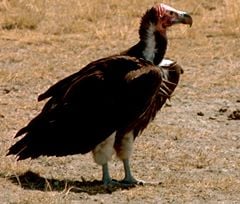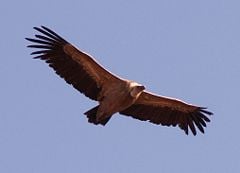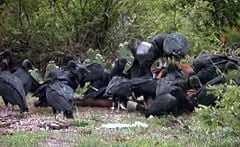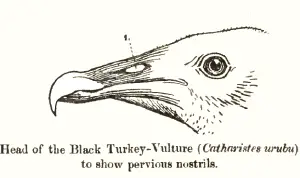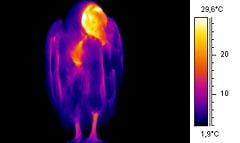Difference between revisions of "Vulture" - New World Encyclopedia
Rick Swarts (talk | contribs) |
Rick Swarts (talk | contribs) |
||
| (11 intermediate revisions by 4 users not shown) | |||
| Line 1: | Line 1: | ||
| − | {{ | + | {{Copyedited}}{{Approved}}{{Images OK}}{{Submitted}}{{Paid}} |
| − | |||
{{Taxobox | {{Taxobox | ||
| color = pink | | color = pink | ||
| Line 13: | Line 12: | ||
| subdivision = | | subdivision = | ||
[[Falconiformes]] (Fam. [[Accipitridae]] (part))<br> | [[Falconiformes]] (Fam. [[Accipitridae]] (part))<br> | ||
| − | [[Ciconiiformes]] (Fam. [[Cathartidae]]) | + | [[Ciconiiformes]] (Fam. [[Cathartidae]])) |
}} | }} | ||
| − | [[ | + | '''Vulture''' is the common name for various large [[birds of prey]] within the family Accipitridae (Old World vultures) and the family Cathartidae (New World vultures), typically characterized by a featherless head, keen sight, good soaring ability, and generally [[scavenger|scavenging]] behavior, feeding mostly on the carcasses of dead [[animal]]s. Vultures are found in every continent except [[Antarctica]] and [[Oceania]]. |
| − | + | The Old World Vultures are in the same family as [[eagle]]s, [[buzzard]]s and [[hawk]]s, while the New World Vultures (including two species called [[condor]]s), which comprise the entire family Cathartidae, are considered by some to be more closely related to [[stork]]s. | |
A particular characteristic of many vultures is a bald [[head (anatomy)|head]], devoid of [[feather]]s. This is likely because a feathered head would become spattered with [[blood]] and other fluids, and thus be difficult to keep clean. | A particular characteristic of many vultures is a bald [[head (anatomy)|head]], devoid of [[feather]]s. This is likely because a feathered head would become spattered with [[blood]] and other fluids, and thus be difficult to keep clean. | ||
| − | A group of vultures is occasionally called a ''venue'', and when circling in the air a group of vultures is called a ''kettle''. | + | While in the Western world, the term "vulture" tends to have unfavorable connotations—being used as a metaphor for those who prey on the weak or dying—these birds actually play a very valuable role in [[ecosystem]]s as scavengers, removing dead animals. Indeed, the reduction of the number of vultures in some areas due to diclofenac poisoning (from consuming dead farm animals given this [[NSAID]]), has led to rotting carcasses and to greater numbers of [[rabies]] carrying [[rodent]]s. In some areas of the world, vultures have a more favorable image, including being associated with loving, bonding, mothering, and protecting due to the vultures being seen together, with mother and child bonded together. |
| + | |||
| + | A group of vultures is occasionally called a ''venue'', and when circling in the air a group of vultures is called a ''kettle''. The word ''[[Geier]]'' (taken from the [[German language]]) does not have a precise meaning in [[ornithology]], and it is occasionally used to refer to a vulture in English, as in some poetry. | ||
==Classification== | ==Classification== | ||
| − | Vultures are classified into two groups: Old World vultures and New World vultures. The similarities between the two different groups are due to [[convergent evolution]]. | + | Vultures are classified into two groups: Old World vultures and New World vultures. These are not closely related and are sometimes placed in different orders—Old World vultures in the order Falconiformes and New World vultures in the order Ciconiiformes—although traditionally they have both been placed in the Falconiformes order. The similarities between the two different groups are considered to be due to [[convergent evolution]]. |
===Old World vultures=== | ===Old World vultures=== | ||
| + | [[Image:Nubianvulture.jpeg|thumb|right|240px|Old World vulture: Nubian Vulture or Lappet-faced Vulture]] | ||
{{main|Old World vulture}} | {{main|Old World vulture}} | ||
| − | The [[Old World vulture]]s found in [[Africa]], [[Asia]] and [[Europe]] belong to the family [[Accipitridae]], which also includes [[eagle]]s, [[kite (bird)|kites]], [[buzzard]]s and [[hawk]]s. Old World vultures find carcasses exclusively by sight. | + | The [[Old World vulture]]s, found in [[Africa]], [[Asia]] and [[Europe]], belong to the family [[Accipitridae]], which also includes [[eagle]]s, [[kite (bird)|kites]], [[buzzard]]s, and [[hawk]]s. Old World vultures find carcasses exclusively by sight. |
| − | + | Old World vultures, which are not closely related to the superficially similar [[New World vulture]]s and [[condor]]s, do not share good sense of [[olfaction|smell]] of some of the New World vultures. As scavenging [[bird]]s, feeding mostly from carcasses of dead [[animal]]s, Old World vultures find carcasses exclusively by sight. | |
| − | |||
| − | |||
| − | |||
| − | |||
| − | |||
| − | |||
| − | |||
| − | |||
| − | |||
| − | |||
| − | |||
| − | |||
| − | |||
| − | |||
| − | |||
| − | + | [[Image:Vulture 19o05.jpg|right|240px|thumb|Griffon Vulture soaring]] | |
| + | Old World vultures include 16 species scattered within nine [[genus|genera]] within the Accipitridae family: | ||
| − | + | *Genus ''Aegypius'' | |
| − | + | ** [[Eurasian black vulture]] or monk vulture, ''Aegypius monachus'' | |
| − | + | *Genus ''Gypaetus'' | |
| − | + | ** [[Lammergeier]] or bearded vulture, ''Gypaetus barbatus'' | |
| − | + | *Genus ''Gypohierax'' | |
| − | + | ** [[Palm-nut vulture]], ''Gypohierax angolensis'' | |
| − | + | *Genus ''Gyps'' | |
| − | + | ** [[Griffon vulture]], ''Gyps fulvus'' | |
| − | ' | + | ** [[Indian white-rumped vulture]], ''Gyps bengalensis'' |
| − | * [[Eurasian | + | ** [[Rüppell's vulture]], ''Gyps rueppelli'' |
| − | '' | + | ** [[Long-billed vulture]], ''Gyps indicus'' |
| − | * [[Lammergeier]] or | + | ** [[Slender-billed vulture]], ''Gyps tenuirostris'' |
| − | '' | + | ** [[Himalayan griffon vulture]], ''Gyps himalayensis'' |
| − | * [[Palm-nut | + | ** [[White-backed vulture]], ''Gyps africanus'' |
| − | '' | + | ** [[Cape griffon]], ''Gyps coprotheres'' |
| − | * [[Griffon | + | *Genus ''Necrosyrtes'' |
| − | * [[Indian | + | ** [[Hooded vulture]], ''Necrosyrtes monachus'' |
| − | * [[Rüppell's | + | *Genus ''Neophron'' |
| − | * [[Long-billed | + | ** [[Egyptian vulture]], ''Neophron percnopterus'' |
| − | * [[Slender-billed | + | *Genus ''Sarcogyps'' |
| − | * [[Himalayan | + | ** [[Red-headed vulture]], ''Sarcogyps calvus'' |
| − | * [[White-backed | + | *Genus ''Torgos'' |
| − | * [[Cape | + | ** [[Lappet-faced Vulture]], ''Torgos tracheliotus'' |
| − | '' | + | *Genus ''Trigonoceps'' |
| − | * [[Hooded | + | **[[White-headed vulture]], ''Trigonoceps occipitalis'' |
| − | '' | ||
| − | * [[Egyptian | ||
| − | '' | ||
| − | * [[Red-headed | ||
| − | '' | ||
| − | * [[Lappet-faced Vulture]], ''Torgos tracheliotus'' | ||
| − | '' | ||
| − | * [[White-headed | ||
| − | |||
| − | |||
| − | |||
===New World vultures=== | ===New World vultures=== | ||
{{main|New World vulture}} | {{main|New World vulture}} | ||
| − | + | [[Image:BlackVulture2.JPG|thumb|right|240px|New World vulture: [[American black vulture]]s on a cow carcass]] | |
| + | The [[New World vulture]]s, found in warm and temperate areas of the [[Americas]], comprise the family [[Cathartidae]]. New World vultures are considered not to be closely related to the superficially similar Old World vultures of the Accipitridae family. Traditionally these two groups of vultures were placed together in the order Falconiformes, but some place the New World vultures in a separate order, Ciconiiformes, with the [[stork]]s (family Ciconiidae). Several species of New World vultures have a good sense of smell, unusual for [[Bird of prey|raptor]]s. | ||
| − | + | The New World vultures comprise seven species in five genera, including two species known as [[condor]]s (the Andean condor, ''Vultur gryphus'', and the California condor, ''Gymnogyps californianus''). The genera are ''[[Coragyps]]'', ''[[Cathartes]]'', ''[[Gymnogyps]]'', ''[[Sarcoramphus]]'', and ''[[Vultur]]''. Of these, only ''Cathartes'' is not [[monotypic]]. | |
| − | |||
| − | |||
| − | |||
| − | |||
| − | |||
| − | |||
| − | |||
| − | |||
| − | |||
| − | |||
| − | |||
| − | |||
| − | |||
| − | |||
| − | |||
| − | |||
| − | |||
| − | |||
| − | |||
| − | |||
| − | |||
| − | |||
| − | |||
| − | |||
| − | |||
| − | |||
| − | |||
| − | |||
| − | |||
| − | |||
| − | |||
| − | |||
| − | |||
| − | |||
| − | |||
| − | |||
| − | |||
| − | |||
| − | |||
| − | |||
| − | |||
| − | |||
| − | |||
| − | New World vultures have | + | [[Image:VultureBeak.png |thumb|The New World vultures have a pervious nostril.]] |
| − | + | New World vultures are generally large [[bird]]s, ranging in length from the [[Lesser Yellow-headed Vulture]] at 56–61 centimeters (22–24 inches) up to the [[California Condor|California]] and [[Andean Condor]]s, both of which can reach 120 centimeters (48 inches) in length and weigh 12 or more kilograms (26 or more pounds). Plumage is predominantly black or brown, and is sometimes marked with white. All species have featherless heads and necks (Zim et al. 2001). In some, this skin is brightly colored, and in the [[king vulture]] it is developed into colorful wattles and outgrowths. All species have long, broad wings and a stiff tail, suitable for soaring (Reed 1914). They are the best adapted to soaring of all land birds (Ryser and Ryser 1985). All New World vultures lack a [[syrinx (biology)|syrinx]], the vocal organ of birds, therefore the voice is limited to infrequent grunts and hisses (Howell and Webb 1995; Kemp and Newton 2003). The nasal passage is not divided by a [[nasal septum|septum]] (they are "perforate"), so from the side one can see through the beak, as in the [[Turkey Vulture]] (Allaby 1992). | |
| − | |||
| − | |||
| − | + | The seven extant species of New World vultures are: | |
| + | *[[American black vulture]], ''Coragyps atratus'' | ||
| + | *[[Turkey vulture]] ''Cathartes aura'' | ||
| + | *[[Lesser yellow-headed vulture]], ''Cathartes burrovianus'' | ||
| + | *[[Greater yellow-headed vulture]], ''Cathartes melambrotus'' | ||
| + | *[[California condor]], ''Gymnogyps californianus'' | ||
| + | *[[Andean condor]], ''Vultur gryphus'' | ||
| + | *[[King vulture]], ''Sarcoramphus papa'' | ||
== Feeding == | == Feeding == | ||
[[Image:White-backed vultures eating a dead wildebeest.JPG|thumb|right|240px|A group of [[White-backed Vulture]]s eating the carcass of a [[Wildebeest]].]] | [[Image:White-backed vultures eating a dead wildebeest.JPG|thumb|right|240px|A group of [[White-backed Vulture]]s eating the carcass of a [[Wildebeest]].]] | ||
| − | Vultures seldom attack healthy animals, but may kill the wounded or sick. | + | Vultures are scavengers, typically feeding on the carcass of dead animals. However, the palm-nut vulture, ''Gypohierax angolensis'', an Old World vulture, while it will eat dead [[fish]], is unique for a bird of prey in not preferring meat, but rather the the nut of the oil palm. All living species of New World vultures and condors are [[scavenger]]s. Indeed, the beak of New World vultures is quite weak, being adapted to feeding on partially rotted carrion rather than fresh prey. However, some New World vulture species, such as the [[American black vulture]], have been recorded as killing live prey. Other additions to the diet include fruit, eggs, and garbage. |
| + | |||
| + | Vultures seldom attack healthy animals, but may kill the wounded or sick. Vast numbers have been seen upon battlefields. They gorge themselves when prey is abundant, till their [[crop (anatomy)|crop]] bulges, and sit, sleepy or half torpid, to digest their food. They do not carry food to their young in their claws, but disgorge it from the crop. These birds are of great value as scavengers, especially in hot regions. | ||
== Threat due to diclofenac poisoning == | == Threat due to diclofenac poisoning == | ||
[[Image:Wiki vulture2.jpg|thumb|left|240px|Some members of both the old and new world vultures have an unfeathered neck and head, shown as radiating heat in this thermographic image.]] | [[Image:Wiki vulture2.jpg|thumb|left|240px|Some members of both the old and new world vultures have an unfeathered neck and head, shown as radiating heat in this thermographic image.]] | ||
| − | The vulture population in [[India]] and [[Pakistan]] has declined by up to 95 | + | The vulture population in [[India]] and [[Pakistan]] has declined by up to 95 percent recently in the past decade, and two or three of the species of vultures in South Asia are nearing [[extinction]]. This has been caused by the practice of giving working farm animals [[Diclofenac#Ecological problems|diclofenac]], which is a non-steroidal anti-inflammatory drug ([[NSAID]]) with anti-inflammatory and pain killing actions. Diclofenac administration keeps animals that are ill or in pain working on the land for longer, but, if the ill animals die, their carcasses contain diclofenac. Farmers leave the dead animals out in the open, relying on vultures to tidy up. Diclofenac present in carcass flesh is eaten by the vultures, which are sensitive to diclofenac, suffering kidney failure, [[visceral gout]], and death as a result of diclofenac [[poison]]ing. |
| − | The decline in vultures has led to hygiene problems in India as carcasses of dead animals now tend to rot, or be eaten by | + | The decline in vultures has led to hygiene problems in India as carcasses of dead animals now tend to rot, or be eaten by [[rat]]s or wild dogs, rather than be tidied up by vultures. [[Rabies]] among these scavengers is a major health threat. India has the world's highest rate of rabies. |
The decline in vultures causes particular problems for certain communities, such as the [[Parsi]], who practice [[sky burial]]s, where the human dead are put on the top of [[Towers of Silence]] and are eaten by vultures, leaving only dry bones. | The decline in vultures causes particular problems for certain communities, such as the [[Parsi]], who practice [[sky burial]]s, where the human dead are put on the top of [[Towers of Silence]] and are eaten by vultures, leaving only dry bones. | ||
| − | [[Meloxicam]] (another NSAID) has been found to be harmless to vultures and should prove an acceptable alternative to diclofenac. The Government of India banned diclofenac, but it continues to be sold over a year later and is still a problem in other parts of the world. | + | [[Meloxicam]] (another NSAID) has been found to be harmless to vultures and should prove an acceptable alternative to diclofenac. The Government of India banned diclofenac, but it continues to be sold over a year later and is still a problem in other parts of the world (NS 2006). |
== Vultures in culture == | == Vultures in culture == | ||
| − | + | In Southern Africa, the name for a [[Lappet-faced vulture|Nubian vulture]] is synonymous with the term applied to [[love]]rs, because these vultures are always seen in pairs, mother and child remaining closely bonded together. Pairing, bonding, protecting, and loving are essential attributes associated with the vulture. | |
| − | In Southern Africa, the name for a [[Lappet-faced vulture|Nubian vulture]] is synonymous with the term applied to [[love]]rs, because these vultures are always seen in pairs, mother and child remaining closely bonded together. Pairing, bonding, protecting, and loving are essential attributes associated with the vulture | + | |
| + | The [[Egypt]]ians considered the vulture an excellent mother, and its wide wingspan was seen as all-encompassing and providing a protective cover to its infants. The vulture [[Egyptian hieroglyphs|hieroglyph]] <hiero>A</hiero> was the [[Egyptian uniliteral signs|uniliteral sign]] used for the glottal sound (''three'') including words such as ''mother'', ''prosperous'', ''grandmother'', and ''ruler''. | ||
| − | In the Western world, the image of the vulture is far more negative, with | + | In the Western world, the image of the vulture is far more negative, with vulture used as a metaphor for those who prey on the weak or dying, with associated negative connotations of cowardice and selfishness (although the vulture plays an important natural role). |
==References== | ==References== | ||
| − | * Ferguson-Lees, | + | * Allaby, M. 1992. ''The Concise Oxford Dictionary of Zoology''. Oxford: Oxford University Press. ISBN 0192860933. |
| − | * Grimmett, Inskipp | + | * British Broadcasting Corporation (BBC). 2006. [http://news.bbc.co.uk/1/hi/sci/tech/4670736.stm Bird groups hopeful on vultures] ''BBC'' February 1, 2006. Retrieved January 26, 2008. |
| − | * Hilty, '' Birds of Venezuela'', ISBN | + | * Ferguson-Lees, J., and D. Christie. 2001. ''Raptors of the World''. London: Christopher Helm. ISBN 0713680261. |
| − | * | + | * Gentleman, A. 2006. India's vultures fall prey to a drug in the cattle they feed on. ''New York Times'', March 28, 2006. |
| − | * [http:// | + | * Grimmett, R., C. Inskipp, T. Inskipp, and R. Grimmett. 1999. ''Birds of India, Pakistan, Nepal, Bangladesh, Bhutan, Sri Lanka, and the Maldives''. Princeton field guides. Princeton, N.J.: Princeton University Press. ISBN 0691049106. |
| − | * | + | * Hilty, S. L. 2003. ''Birds of Venezuela''. Helm field guides. London: Christopher Helm. ISBN 0713664185. |
| + | * Howell, S. N.G., and S. Webb. 1995. ''A Guide to the Birds of Mexico and Northern Central America.'' New York: Oxford University Press. ISBN 0198540124. | ||
| + | * Kemp, A., and I. Newton. 2003. New World vultures. In C. Perrins, ed., ''The Firefly Encyclopedia of Birds''. Firefly Books. ISBN 1552977773. | ||
| + | * New Scientists (NS). 2006. [http://www.newscientisttech.com/article.ns?id=mg19225774.300&feedId=online-news_rss20 Painkillers turned bird killers] ''New Scientist Tech'' (from ''New Scientist Magazine'', issue 2577, November 14, 2006). Retrieved January 26, 2008. | ||
| + | * Reed, C. A. 1914. ''The Bird Book: Illustrating in Natural Colors More Than Seven Hundred North American Birds''. The University of Wisconsin. | ||
| + | * Ryser, F. A. 1985. ''Birds of the Great Basin: A Natural History''. University of Nevada Press. ISBN 087417080X. | ||
| + | * Sinclair, I., P. Hockey, and W. R. Tarboton. 2002. ''Sasol Birds of Southern Africa''. Cape Town: Struik. ISBN 1868727211. | ||
| + | * van Wyka, E., H. van der Bank, and G. H. Verdoorn. 2001. Allozyme variation in four populations of African whitebacked vultures (''Gyps africanus'') and phylogenetic relationships between four vulture species from southern Africa. ''Biochemical Systematics and Ecology'' 29: 485–512. | ||
| + | * Zim, H. S., C. S. Robbins, and B. Bruun. 2001. ''Birds of North America: A Guide to Field Identification''. Golden Publishing. ISBN 1582380902. | ||
| − | + | [[Category:Life sciences]] | |
| − | + | [[Category:Animals]][[Category:Birds]] | |
| − | |||
| − | + | {{credit|Vulture|174226177|Old_World_vulture|175773129|New_World_vulture|176069708}} | |
| − | |||
| − | |||
| − | {{credit|Vulture|174226177}} | ||
Latest revision as of 01:14, 30 May 2008
| 'Vultures' | ||||||
|---|---|---|---|---|---|---|
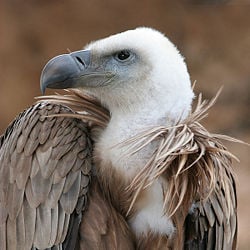 Griffon vulture, Gyps fulvus
| ||||||
| Scientific classification | ||||||
| ||||||
|
Falconiformes (Fam. Accipitridae (part)) |
Vulture is the common name for various large birds of prey within the family Accipitridae (Old World vultures) and the family Cathartidae (New World vultures), typically characterized by a featherless head, keen sight, good soaring ability, and generally scavenging behavior, feeding mostly on the carcasses of dead animals. Vultures are found in every continent except Antarctica and Oceania.
The Old World Vultures are in the same family as eagles, buzzards and hawks, while the New World Vultures (including two species called condors), which comprise the entire family Cathartidae, are considered by some to be more closely related to storks.
A particular characteristic of many vultures is a bald head, devoid of feathers. This is likely because a feathered head would become spattered with blood and other fluids, and thus be difficult to keep clean.
While in the Western world, the term "vulture" tends to have unfavorable connotations—being used as a metaphor for those who prey on the weak or dying—these birds actually play a very valuable role in ecosystems as scavengers, removing dead animals. Indeed, the reduction of the number of vultures in some areas due to diclofenac poisoning (from consuming dead farm animals given this NSAID), has led to rotting carcasses and to greater numbers of rabies carrying rodents. In some areas of the world, vultures have a more favorable image, including being associated with loving, bonding, mothering, and protecting due to the vultures being seen together, with mother and child bonded together.
A group of vultures is occasionally called a venue, and when circling in the air a group of vultures is called a kettle. The word Geier (taken from the German language) does not have a precise meaning in ornithology, and it is occasionally used to refer to a vulture in English, as in some poetry.
Classification
Vultures are classified into two groups: Old World vultures and New World vultures. These are not closely related and are sometimes placed in different orders—Old World vultures in the order Falconiformes and New World vultures in the order Ciconiiformes—although traditionally they have both been placed in the Falconiformes order. The similarities between the two different groups are considered to be due to convergent evolution.
Old World vultures
The Old World vultures, found in Africa, Asia and Europe, belong to the family Accipitridae, which also includes eagles, kites, buzzards, and hawks. Old World vultures find carcasses exclusively by sight.
Old World vultures, which are not closely related to the superficially similar New World vultures and condors, do not share good sense of smell of some of the New World vultures. As scavenging birds, feeding mostly from carcasses of dead animals, Old World vultures find carcasses exclusively by sight.
Old World vultures include 16 species scattered within nine genera within the Accipitridae family:
- Genus Aegypius
- Eurasian black vulture or monk vulture, Aegypius monachus
- Genus Gypaetus
- Lammergeier or bearded vulture, Gypaetus barbatus
- Genus Gypohierax
- Palm-nut vulture, Gypohierax angolensis
- Genus Gyps
- Griffon vulture, Gyps fulvus
- Indian white-rumped vulture, Gyps bengalensis
- Rüppell's vulture, Gyps rueppelli
- Long-billed vulture, Gyps indicus
- Slender-billed vulture, Gyps tenuirostris
- Himalayan griffon vulture, Gyps himalayensis
- White-backed vulture, Gyps africanus
- Cape griffon, Gyps coprotheres
- Genus Necrosyrtes
- Hooded vulture, Necrosyrtes monachus
- Genus Neophron
- Egyptian vulture, Neophron percnopterus
- Genus Sarcogyps
- Red-headed vulture, Sarcogyps calvus
- Genus Torgos
- Lappet-faced Vulture, Torgos tracheliotus
- Genus Trigonoceps
- White-headed vulture, Trigonoceps occipitalis
New World vultures
The New World vultures, found in warm and temperate areas of the Americas, comprise the family Cathartidae. New World vultures are considered not to be closely related to the superficially similar Old World vultures of the Accipitridae family. Traditionally these two groups of vultures were placed together in the order Falconiformes, but some place the New World vultures in a separate order, Ciconiiformes, with the storks (family Ciconiidae). Several species of New World vultures have a good sense of smell, unusual for raptors.
The New World vultures comprise seven species in five genera, including two species known as condors (the Andean condor, Vultur gryphus, and the California condor, Gymnogyps californianus). The genera are Coragyps, Cathartes, Gymnogyps, Sarcoramphus, and Vultur. Of these, only Cathartes is not monotypic.
New World vultures are generally large birds, ranging in length from the Lesser Yellow-headed Vulture at 56–61 centimeters (22–24 inches) up to the California and Andean Condors, both of which can reach 120 centimeters (48 inches) in length and weigh 12 or more kilograms (26 or more pounds). Plumage is predominantly black or brown, and is sometimes marked with white. All species have featherless heads and necks (Zim et al. 2001). In some, this skin is brightly colored, and in the king vulture it is developed into colorful wattles and outgrowths. All species have long, broad wings and a stiff tail, suitable for soaring (Reed 1914). They are the best adapted to soaring of all land birds (Ryser and Ryser 1985). All New World vultures lack a syrinx, the vocal organ of birds, therefore the voice is limited to infrequent grunts and hisses (Howell and Webb 1995; Kemp and Newton 2003). The nasal passage is not divided by a septum (they are "perforate"), so from the side one can see through the beak, as in the Turkey Vulture (Allaby 1992).
The seven extant species of New World vultures are:
- American black vulture, Coragyps atratus
- Turkey vulture Cathartes aura
- Lesser yellow-headed vulture, Cathartes burrovianus
- Greater yellow-headed vulture, Cathartes melambrotus
- California condor, Gymnogyps californianus
- Andean condor, Vultur gryphus
- King vulture, Sarcoramphus papa
Feeding
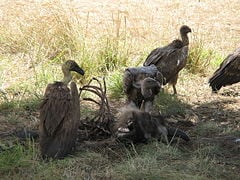
Vultures are scavengers, typically feeding on the carcass of dead animals. However, the palm-nut vulture, Gypohierax angolensis, an Old World vulture, while it will eat dead fish, is unique for a bird of prey in not preferring meat, but rather the the nut of the oil palm. All living species of New World vultures and condors are scavengers. Indeed, the beak of New World vultures is quite weak, being adapted to feeding on partially rotted carrion rather than fresh prey. However, some New World vulture species, such as the American black vulture, have been recorded as killing live prey. Other additions to the diet include fruit, eggs, and garbage.
Vultures seldom attack healthy animals, but may kill the wounded or sick. Vast numbers have been seen upon battlefields. They gorge themselves when prey is abundant, till their crop bulges, and sit, sleepy or half torpid, to digest their food. They do not carry food to their young in their claws, but disgorge it from the crop. These birds are of great value as scavengers, especially in hot regions.
Threat due to diclofenac poisoning
The vulture population in India and Pakistan has declined by up to 95 percent recently in the past decade, and two or three of the species of vultures in South Asia are nearing extinction. This has been caused by the practice of giving working farm animals diclofenac, which is a non-steroidal anti-inflammatory drug (NSAID) with anti-inflammatory and pain killing actions. Diclofenac administration keeps animals that are ill or in pain working on the land for longer, but, if the ill animals die, their carcasses contain diclofenac. Farmers leave the dead animals out in the open, relying on vultures to tidy up. Diclofenac present in carcass flesh is eaten by the vultures, which are sensitive to diclofenac, suffering kidney failure, visceral gout, and death as a result of diclofenac poisoning.
The decline in vultures has led to hygiene problems in India as carcasses of dead animals now tend to rot, or be eaten by rats or wild dogs, rather than be tidied up by vultures. Rabies among these scavengers is a major health threat. India has the world's highest rate of rabies.
The decline in vultures causes particular problems for certain communities, such as the Parsi, who practice sky burials, where the human dead are put on the top of Towers of Silence and are eaten by vultures, leaving only dry bones.
Meloxicam (another NSAID) has been found to be harmless to vultures and should prove an acceptable alternative to diclofenac. The Government of India banned diclofenac, but it continues to be sold over a year later and is still a problem in other parts of the world (NS 2006).
Vultures in culture
In Southern Africa, the name for a Nubian vulture is synonymous with the term applied to lovers, because these vultures are always seen in pairs, mother and child remaining closely bonded together. Pairing, bonding, protecting, and loving are essential attributes associated with the vulture.
The Egyptians considered the vulture an excellent mother, and its wide wingspan was seen as all-encompassing and providing a protective cover to its infants. The vulture hieroglyph
| |
was the uniliteral sign used for the glottal sound (three) including words such as mother, prosperous, grandmother, and ruler.
In the Western world, the image of the vulture is far more negative, with vulture used as a metaphor for those who prey on the weak or dying, with associated negative connotations of cowardice and selfishness (although the vulture plays an important natural role).
ReferencesISBN links support NWE through referral fees
- Allaby, M. 1992. The Concise Oxford Dictionary of Zoology. Oxford: Oxford University Press. ISBN 0192860933.
- British Broadcasting Corporation (BBC). 2006. Bird groups hopeful on vultures BBC February 1, 2006. Retrieved January 26, 2008.
- Ferguson-Lees, J., and D. Christie. 2001. Raptors of the World. London: Christopher Helm. ISBN 0713680261.
- Gentleman, A. 2006. India's vultures fall prey to a drug in the cattle they feed on. New York Times, March 28, 2006.
- Grimmett, R., C. Inskipp, T. Inskipp, and R. Grimmett. 1999. Birds of India, Pakistan, Nepal, Bangladesh, Bhutan, Sri Lanka, and the Maldives. Princeton field guides. Princeton, N.J.: Princeton University Press. ISBN 0691049106.
- Hilty, S. L. 2003. Birds of Venezuela. Helm field guides. London: Christopher Helm. ISBN 0713664185.
- Howell, S. N.G., and S. Webb. 1995. A Guide to the Birds of Mexico and Northern Central America. New York: Oxford University Press. ISBN 0198540124.
- Kemp, A., and I. Newton. 2003. New World vultures. In C. Perrins, ed., The Firefly Encyclopedia of Birds. Firefly Books. ISBN 1552977773.
- New Scientists (NS). 2006. Painkillers turned bird killers New Scientist Tech (from New Scientist Magazine, issue 2577, November 14, 2006). Retrieved January 26, 2008.
- Reed, C. A. 1914. The Bird Book: Illustrating in Natural Colors More Than Seven Hundred North American Birds. The University of Wisconsin.
- Ryser, F. A. 1985. Birds of the Great Basin: A Natural History. University of Nevada Press. ISBN 087417080X.
- Sinclair, I., P. Hockey, and W. R. Tarboton. 2002. Sasol Birds of Southern Africa. Cape Town: Struik. ISBN 1868727211.
- van Wyka, E., H. van der Bank, and G. H. Verdoorn. 2001. Allozyme variation in four populations of African whitebacked vultures (Gyps africanus) and phylogenetic relationships between four vulture species from southern Africa. Biochemical Systematics and Ecology 29: 485–512.
- Zim, H. S., C. S. Robbins, and B. Bruun. 2001. Birds of North America: A Guide to Field Identification. Golden Publishing. ISBN 1582380902.
Credits
New World Encyclopedia writers and editors rewrote and completed the Wikipedia article in accordance with New World Encyclopedia standards. This article abides by terms of the Creative Commons CC-by-sa 3.0 License (CC-by-sa), which may be used and disseminated with proper attribution. Credit is due under the terms of this license that can reference both the New World Encyclopedia contributors and the selfless volunteer contributors of the Wikimedia Foundation. To cite this article click here for a list of acceptable citing formats.The history of earlier contributions by wikipedians is accessible to researchers here:
The history of this article since it was imported to New World Encyclopedia:
Note: Some restrictions may apply to use of individual images which are separately licensed.
